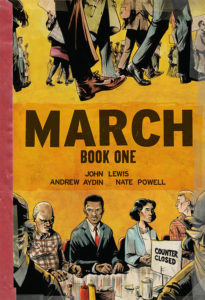Comics and graphic novels have been having a good run lately. Comichron and ICv2 – respectively, a database and journal covering the industry – estimate that, in 2015, total domestic sales reached a record of $1.03 billion. In their joint report, they note that in 2015, print sales accounted for a staggering $940 million, with about $535 million coming from graphic novels and $405 million from comic books; compare to 2000, when sales grossed a relatively modest $265 million. Ted Adams, CEO of IDW Media, noted that this market is quite stable: “At IDW, the huge growth we saw in digital sales in the early days of eBooks flattened from 2015 to 2016. It’s still a significant revenue stream — measured at around 11.5% of physical sales — and I expect we’ll see growth in the near future as more players enter the storefront marketplace and new technologies develop.”
However, digital sales of both comics and graphic novels accounted for only $90 million of the total, and that $90 million sum represents 9% of total sales, a 10% decline from the same category in 2014. A 9% share of sales seems low nearly a decade out from the launch of the Kindle, especially by comparison to other ebook categories. Genre does matter a great deal when it comes to electronic sales. Forbes pegged text-based ebooks at 30% of sales in 2014, and for some categories like romance, it’s over 50%. And digital comics and graphic novels actually do better than their neighbors in other visual genres: ebooks anecdotally account for only about 3% of the illustrated book market. Why is this?
The Books in Question
This a rticle will use the terms “comics” and “graphic novels” to mean the same broad genre, but there is a subtle distinction to note. Both tell stories through the combination of words and images, but comics are episodic or serialized before being collected in volumes, while it’s usually accurate to think of graphic novels as being self-contained. DC Comics’ Superman and Alison Bechdel’s memoir Fun Home are, respectively, a comics series and a graphic novel. (Of course, not all comics series are superhero-related – there’s actually a long history of realistic comics, as well as a thriving and subversive “underground” – but that’s another article.)
rticle will use the terms “comics” and “graphic novels” to mean the same broad genre, but there is a subtle distinction to note. Both tell stories through the combination of words and images, but comics are episodic or serialized before being collected in volumes, while it’s usually accurate to think of graphic novels as being self-contained. DC Comics’ Superman and Alison Bechdel’s memoir Fun Home are, respectively, a comics series and a graphic novel. (Of course, not all comics series are superhero-related – there’s actually a long history of realistic comics, as well as a thriving and subversive “underground” – but that’s another article.)
A comics store will obviously sell comics, but many stock a selection of graphic novels too. A traditional bookstore might sell both but have more limited stock of comics on the shelves. Many authors and illustrators work in both forms. Graphic novels, though sometimes considered to have higher literary merit, are very close to their comics kin. Both are read widely across genders and age groups. In other words, the nuance is important, but these are two fundamentally similar types of books.
What Is Being Sold?
In the case of investigating digital sales, it’s best to assign digital comics three broad components: formatting, buyability, and audience.
First, to make digital comics readable there are very basic formatting problems to solve. To be sure, many vendors of comics and graphic novels are tackling the readability issue head-on. “Guided View” breaks a comic down to its component panels, moving the reader over a particular page in a predetermined order; this is meant to mimic the way an eye moves over an image. “Regular” view – i.e., a page spread converted into a single image file, with the ability to zoom and scroll – is still buyable too, and is the standard for DRM-free downloads and user-purchase backups. Neither is a perfect solution, though. A comic formatted for print is designed to be taken in a whole page at a time, with the images’ juxtaposition itself providing extratextual content. Guided View may provide a path through a comic, but it’s not a perfect replica of the physical experience.
 That’s not to say that the physical experience always comes first anymore: some comics aren’t initially designed for print, further complicating the story around digital sales. More than a few titles began their lives on the web and later made the transition to print books and ebooks simultaneously. Noelle Stevenson’s Nimona (HarperCollins) is one such case: it ran in serial format on her website before publication. Tom Gauld’s first collection, You’re All Just Jealous of My Jetpack (Drawn & Quarterly), is a compilation of comics published in the Guardian and on his own website, but his graphic novels Goliath and Mooncop (both also Drawn & Quarterly) had not previously appeared either online or off. John Lewis’s prize-winning March trilogy (Top Shelf), by contrast, was designed in homage to a civil rights comic book from the 1950s and therefore did draw directly from print. There isn’t a default route through these mediums.
That’s not to say that the physical experience always comes first anymore: some comics aren’t initially designed for print, further complicating the story around digital sales. More than a few titles began their lives on the web and later made the transition to print books and ebooks simultaneously. Noelle Stevenson’s Nimona (HarperCollins) is one such case: it ran in serial format on her website before publication. Tom Gauld’s first collection, You’re All Just Jealous of My Jetpack (Drawn & Quarterly), is a compilation of comics published in the Guardian and on his own website, but his graphic novels Goliath and Mooncop (both also Drawn & Quarterly) had not previously appeared either online or off. John Lewis’s prize-winning March trilogy (Top Shelf), by contrast, was designed in homage to a civil rights comic book from the 1950s and therefore did draw directly from print. There isn’t a default route through these mediums.
Conversely, not every property is currently available in a digital form. There are relatively few vendors of digital comics, especially now that Scribd has pulled its offerings. Among the most successful are the Amazon-owned comiXology, which offers sales of individual comics as well as a monthly subscription, and Madefire, which focuses on innovative storytelling through its Motion Book Tool. Additionally, individual sales are often available directly from the publisher, and subscription plans are available from – to give a partial accounting – ComicBlitz, Comics Fix, Marvel Unlimited, and the ubiquitous Kindle Unlimited. The digital storefront Humble Bundle offers pay-what-you-want sets of comic books and video games, and proceeds from all sales go toward various charities.
While these are suitable options, they don’t include everything that’s available in print. Both Marvel and DC have yet to produce ebook editions of many Silver Age volumes. Drawn & Quarterly, a renowned independent publisher of artistic comics and graphic novels, first debuted a selection of its catalog on comiXology in September 2015, and as of January 2017 still appears to list only about two dozen titles. Smaller, less-established publishers may not have the resources to produce in more than one medium. So there are two kinds of accessibility: a reader’s access to a book, and a creator’s access to the market.
Who’s Buying?
Finally, while issues of readability and buyability certainly play some role in comic sales, there’s one more factor to note: the sales experience itself. Comic book stores are frequently sites of community. Perhaps that explains why their sales were up in 2016, even with new stores entering the marketplace. June 2016 was the best-selling month for comics book stores since December 1997. If a customer values the camaraderie to be found at their local store, they are not going to be wholly satisfied by online checkout, no matter how efficient. Stores know how to exploit this. Forbidden Planet in New York City hosts signings and other events and keeps in touch with some fourteen thousand followers on Twitter. In this sense, ease of use is almost beside the point.
There are many genres under the comics umbrella, and readers come to comics for just as many reasons. Marvel and DC continue to pull strong numbers, but indie publishers like IDW, Image, Fantagraphics, and Top Shelf are responsible for a wide variety of properties too, among them series like the space epic Saga and the long-running magical realist slice-of-life series Love and Rockets. Increasingly, bigger houses that don’t typically publish visual storytelling are getting involved, which may have some bearing on the continued rise of the market. Scholastic publishes Raina Telgemeier’s graphic novels, while Marjane Satrapi’s Persepolis is published by Pantheon. These properties each have distinct fans and social contexts, and simply making a comic accessible digitally is not the same thing as providing the whole experience.
In Conclusion
The identification of these three components isn’t meant to scare publishers away from pursuing digital comics but to ask them to think critically about the ways in which they do so. It’s difficult at best to exactly replicate the physical experience of reading a print edition, and that goal may not be useful. Perhaps, in the future, comics publishers will look to create a complementary digital experience instead. What’s clear is that readers are hungry for these titles; finding new ways to deliver them satisfactorily will be a challenge, but one well worth undertaking.





